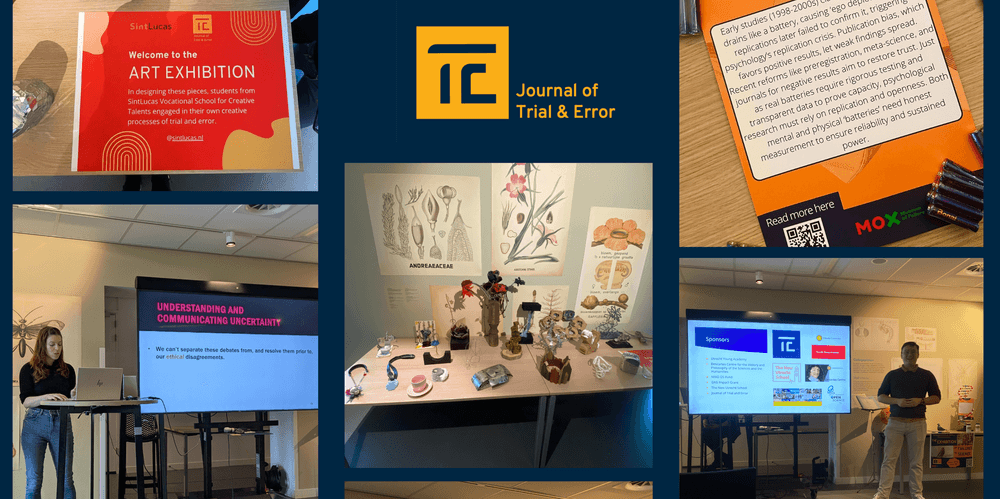~ 10 min read
DOI: https://doi.org/10.36850/r07m-jp48
Sex Differences and Clinical Research: a Reflection on Communicating About Values in Science
This blogpost has been written as run-up to the Dutch National Science Communication Day, where JOTE-members Stefan Gaillard and Marcel Hobma, together with dr. Megan Milota and Robert Dasović present a workshop on values in science. The event is held on the 9th of October. For tickets and more information, please click here. Around three years ago, I stumbled upon a controversial and curious case of scientific dissent and decided to take it up as graduation project for my Bachelor’s in Journalism. At the time, several Dutch news media had reported about the shortage of women in clinical research on newly developed medicine, and warned that by being neglected by the pharmaceutical industry, women where disadvantaged and more likely to suffer from yet undiscovered side-effects. At first, I adopted the newspaper’s perspective and started investigating the participation of women in clinical studies, but when after two months neither evidence of structural exclusion, nor clear victims of under-researched drugs where anywhere to be found, I radically changed my approach: Could it be that the news reports where actually exaggerated?
Based on my quantitative research it sure appeared so: large scale clinical trials conducted in Europe included more women than men, and often looked at sex-differences in effects and side-effects. I started questioning the legitimacy and factuality of the newspaper reports, and found that they were driven on by an activist organisation. In an interview, the activists pointed out that women report way more side-effects from medicine than men, and that as a result, pharmacists should take sex differences as the main variable when studying effects and side-effects of new drugs. Ultimately, I adopted the perspective of the pharmacists instead: the two sexes are just one of the many relevant groups that can be researched – including children, elderly, diabetics, overweight people and more – and it is practically impossible to research a drug for every subgroup. My research culminated into an article published in the Dutch Medical Journal (NTvG), in which I sketched a dichotomy between the (objective) pharmacists and the (subjective) activists [1]. Only later, when during my Master’s in History and Philosophy of Science I joined a summer school on values in science, it dawned upon me that this frame might be unbalanced – and found that science communication as a whole could benefit from a greater emphasis on values in science.
The necessity of values in science
According to philosophers who study values in science, scientists and science communication experts should get rid of the value-free ideal - the idea that science can do without, or should be without values [2]. Instead, they argue that non-epistemic values play a crucial role in science, and raise a range of empirical studies and theoretical arguments to illustrate this point [3]. First, Helen Longino and colleagues have argued that many hypotheses, theories and study conclusions are underdetermined by their evidence [4]. Because a limited amount of evidence can never logically prove a study’s hypothesis or conclusion, there exists a logical gap that leaves room for non-epistemic value-laden assumptions to play an important role in the interpretation of evidence.
A similar gap appears when scientist or science communicator faces an (often unavoidable) risk of error in a study [5]. When there is a possibility of error in a study, how much evidence is needed to accept or reject a certain hypothesis? Values become especially relevant in answering this kind of question when being wrong can have important economical, ecological or health-related consequences. For example, the question on what amount of evidence is necessary before one can call a pesticide ‘safe’ and start applying it to crops, cannot be determined by empirical evidence or logic alone. Instead, researchers and policy makers need to make a choice based on their values: how much uncertainty is acceptable and what level of safety is deemed ‘safe enough’?
Next, philosophers have observed that many concepts and categories used in scientific research can contain values – most notably those concepts that seem to include many different definitions like well-being, intelligence or species [4]. Slight differences in the definition of a concept can contain positive or negative connotations, and have important consequences for the design and interpretation of studies. For example, when studying the effect of a medicine or food product on people’s wellbeing, it is more likely to arrive at a clear positive conclusion if one defines human well-being using specific biomarkers and intermediary endpoints, and harder when using a broader definition that includes emotional and social well-being.
Lastly, scholars have pointed out that the choice of research topic and direction are also necessarily steered by values. Again, only logic and scientific reasoning are not sufficient to determine a research agenda, as there is no such thing as an epistemically correct research agenda [5]. Values therefore play a crucial role during the whole research process - from the conception of the research question and design to the interpretation and dissemination of the results – and thus also have to be considered when writing or publishing about science.
Values and science communication
Authors within the field are predominantly concerned with the question of how to demarcate between ‘good’ values and illegitimate values, as well as finding ways to manage the latter [6]. Attempts to devise universal rules that can distinguish between these values have run into problems, and some authors now recommend to check on a case-by-case basis whether the role of values within a study is desirable or not [4]. A large share of the field, however, agrees that the values within scientific research should align with the public interest: it should reflect the needs of society, serve public-wellbeing or include democratic values. Consequently, they recommend that journalists and other communication experts should be transparent and scrutinize the values within science, and facilitate dialogue between the public and scientists. This would promote critical evaluation of values in science, align the values of scientists with that of the public, and also increase the public’s understanding of science as an essentially social process.
Nevertheless, the scholars note, a large share of science communication does not explicitly recognize the role of values in science and sticks to the value-free ideal. It portrays scientific research as a value-free truth-seeking activity in which social-political factors have no role. When values do play a role, it is often portrayed as a negative ‘bias’ that interferes with the truth-seeking process, for example in critical news reports. These articles might not recognize that science actually needs (public) values to function well, and unintentionally steer the public debate towards discussing scientific misconduct and the legitimacy of certain scientific claims. However, it has been noted that in many cases of scientific controversy it is not misconduct or disagreement about facts, but rather disagreement about values that at issue [5]. In these cases, it is more productive for public debates to focus communication efforts on the value differences between the researchers and the public.
However, some authors have also argued that transparency about values in science could also decrease people’s trust in science, while emphasizing the objective truth-seeking character of science might instead increase public trust [7]. Especially when publishing about controversial topics in which it is important to preserve the public trust, like climate change or vaccinations, being transparent about values and other social factors in the research process might actually be counterproductive. Some authors have even gone as far as to suggest using frames that are more likely to increase public acceptance of findings, while others argue that this could damage the credibility of science [4]. It is therefore recommended to choose very carefully how to be transparent about values. Communicating about values in science can have a range of different consequences, and can therefore be seen as a value-embedded act itself.
Values in clinical research
So what do these considerations hold for my article on the inclusion of women in clinical research? First, the current frame focuses on the possibility of scientific misconduct and conveys an unbalanced image of objective pharmaceutical researchers who are facing subjective activists – something that can be clearly seen in the last subheading: “Science or activism?”. The article thus upholds the value-free ideal, and does not recognize that values still play an important role in the decisions of the clinical researchers: what medicine are studied? Which illnesses are addressed? What methods are used and how many people and what kind of people are included?
Of course, there exist strict standards for clinical research that need to be complied before the local regulating agency will authorize the use and sale of a new drug, but there are still many ethical and economic values that influence the research process, and so, there is still a discussion to be had on these values. Even though my quantitative research found that enough women where included according to the medical standards, the article could perhaps have been used as opportunity to discuss these standards.
In retrospect, it might have been better to focus the article on the values of the two parties, and see where they clash in practice. The current frame focuses on the factuality of the activists’ claim, namely that women are underrepresented in clinical research, and offers the readers a clear-cut rejection of this statement. By writing about the value differences of the pharmacists and activists instead, the article could start an interesting discussion that raises questions and involve the public in the dialogue between the two parties. In addition, this approach could create more understanding for both perspectives – which could contribute to the prevention of politic polarisation – and offer the reader a better, more realistic view on the social character of clinical research.
References
[1]: Hobma, M. (2020). Worden vrouwen echt benadeeld in medicijnonderzoek. Nederlands Tijdschrift voor Geneeskunde. 2020;164:C4680
[2]: The field has roots in feminist studies on masculine values in scientific research. For a recent introduction, see the following work by Elliot, K. (2022). Values in Science. Cambridge University Press.
[3]: Within the field there exist multiple definitions of what values are. It is used to refer to the attitudes of researchers, but also defined as the interests that are being affected by researcher’s choices.
[4]: Elliott, K., (2022). Values in science. Pp.22-31
[5]: de Melo-Martín, I. (2019). The commercialization of the biomedical sciences:(mis) understanding bias. History and Philosophy of the Life Sciences, 41(3), 34.
[6]: Holman, B., & Wilholt, T. (2022). The new demarcation problem. Studies in history and philosophy of science, 91, 211-220.
[7]: John, S. 2018. ‘Epistemic Trust and the Ethics of Science Communication: Against Transparency, Openness, Sincerity and Honesty’. Social Epistemology 32:75–87.

Marcel Hobma is a student in History and Philosophy of Science, and trained as an (investigative) journalist. His interests vary from the Philosophy of Biology to the incentive structure of science. He currently works on his Master's thesis on the cultural evolution of values in nutrition science.




